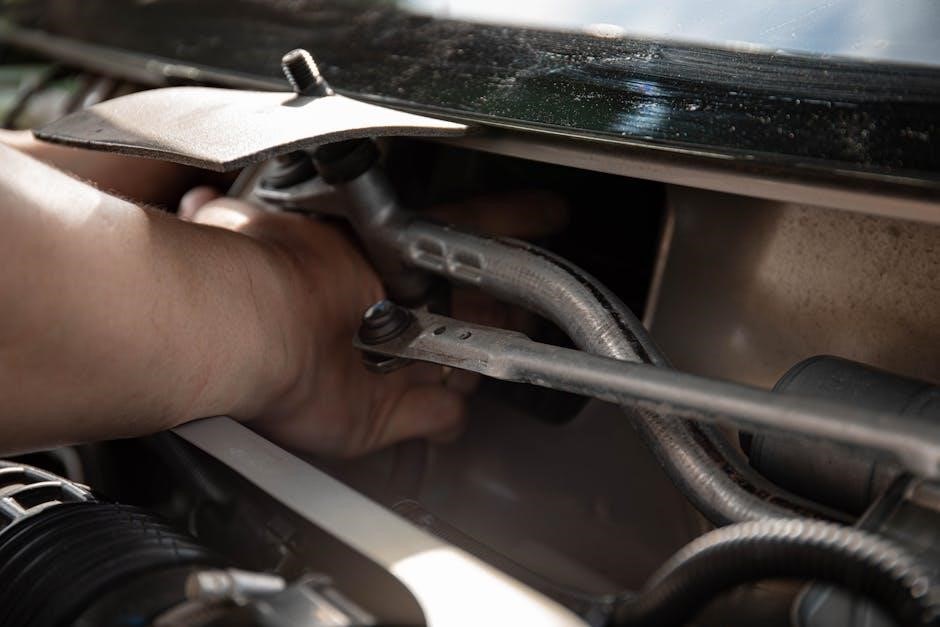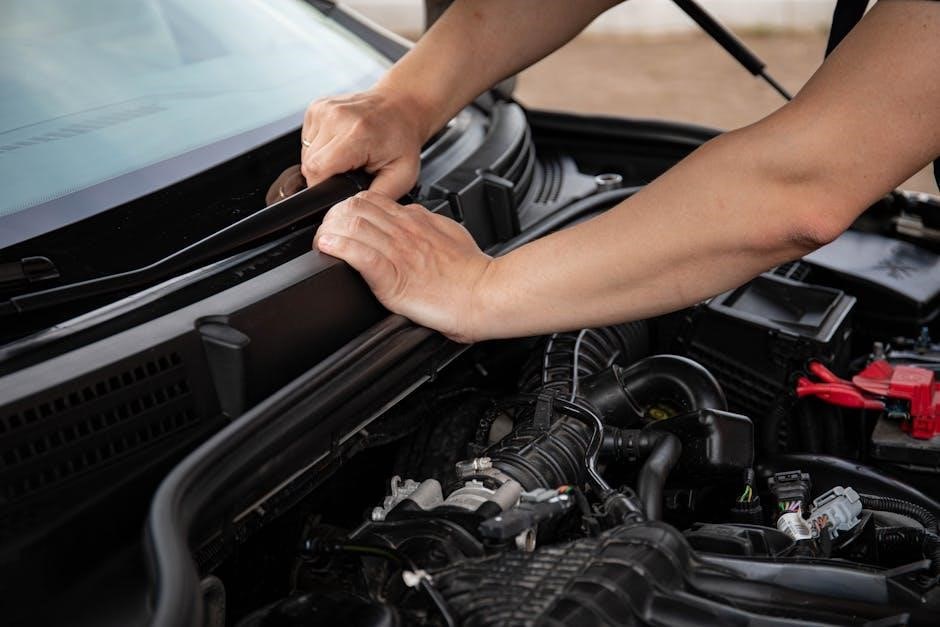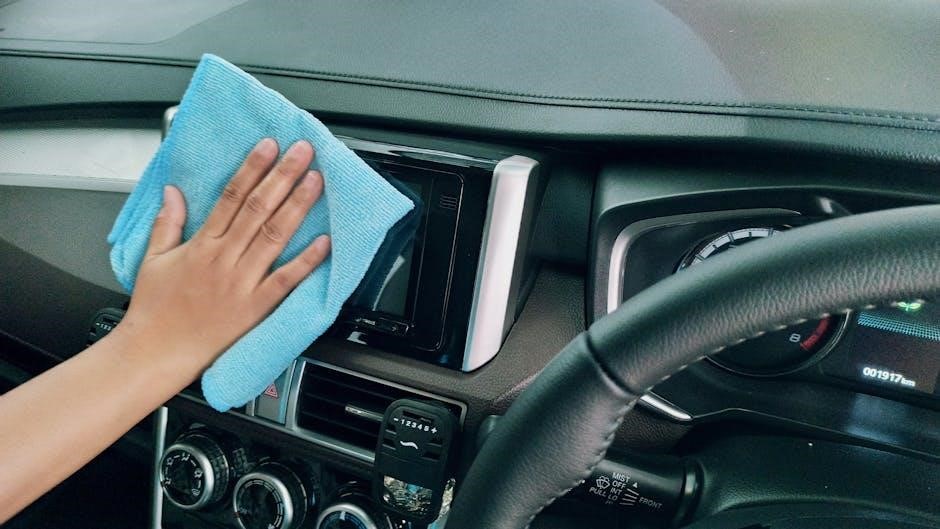A Club Car service manual is a comprehensive guide for maintaining and repairing Club Car vehicles, including golf carts and utility vehicles. It provides detailed instructions, troubleshooting tips, and technical specifications to ensure optimal performance and safety. These manuals are essential for both professionals and DIY enthusiasts, covering routine maintenance, electrical systems, and complex repairs. They help users understand their vehicles better, ensuring longevity and reliability. Proper servicing with these manuals guarantees efficiency and prevents potential issues. Always refer to the official Club Car manual for accurate and safe servicing. This resource is indispensable for anyone owning or servicing Club Car models.
1.1 Overview of Club Car Vehicles
Club Car vehicles are renowned for their versatility, durability, and performance, catering to both recreational and utility purposes. They offer a wide range of models, including electric and gas-powered golf carts, utility vehicles, and transport options. The Precedent, XRT, and Carryall series are among their most popular lines, designed for diverse applications. These vehicles are built with innovative engineering, combining efficiency, comfort, and reliability. Club Car golf carts are widely used on golf courses worldwide, while their utility vehicles serve industrial and commercial needs. The brand is also known for its eco-friendly electric models, which reduce environmental impact. Club Car vehicles are popular for their customizable features, allowing users to tailor them to specific requirements. Whether for leisure or work, Club Car vehicles are trusted for their quality and durability, making them a preferred choice in various industries. Their reputation for reliability has solidified their position as a leader in the market.
1.2 Importance of Service Manuals
Club Car service manuals are essential for ensuring the proper maintenance, repair, and operation of Club Car vehicles. These manuals provide detailed instructions, specifications, and guidelines that help users maintain their vehicles efficiently. By following the manual, owners and technicians can identify potential issues early, preventing costly repairs and extending the vehicle’s lifespan. Service manuals also ensure safety by outlining proper procedures for handling electrical systems, batteries, and other critical components. They empower users with the knowledge to perform routine maintenance, troubleshoot problems, and execute complex repairs confidently. Additionally, these manuals are a valuable resource for understanding technical specifications, warranty requirements, and environmental considerations. Regularly referencing a Club Car service manual helps maintain the vehicle’s performance, reliability, and value. It is a crucial tool for anyone aiming to keep their Club Car running smoothly and safely over the long term.
1.3 Types of Club Car Service Manuals
Club Car offers various service manuals tailored to different vehicle models and user needs. The most common types include the Owner’s Manual, which provides basic operation and maintenance guidelines for owners, and the Service Repair Manual, designed for technicians with detailed repair procedures and technical specifications. There are also Illustrated Parts Lists, which help users identify and order replacement parts. Additionally, Troubleshooting Guides focus on diagnosing common issues, while Wiring Diagrams offer visual representations of electrical systems. Some manuals are specific to vehicle series, such as the Precedent, XRT, or DS models, ensuring relevance and accuracy. Digital and printed versions are available, catering to different preferences. These resources ensure that users have access to the information they need to maintain and repair their Club Car vehicles effectively. The variety of manuals allows owners and technicians to choose the most appropriate resource for their specific requirements.

Maintenance and Repair Guidelines
Maintenance and repair guidelines provide step-by-step instructions for routine servicing and complex fixes. They include schedules for battery care, brake inspections, and electrical system checks. Troubleshooting sections help diagnose issues, while repair instructions offer detailed solutions. These guidelines ensure Club Car vehicles operate safely and efficiently, extending their lifespan and performance. Regular maintenance is crucial for preventing breakdowns and maintaining optimal functionality. By following these guidelines, users can address problems promptly and keep their vehicles in top condition. Proper adherence ensures reliability and safety, making these guidelines indispensable for owners and technicians alike. Always refer to the official manual for accurate procedures tailored to specific models.

2.1 Routine Maintenance Schedules
Routine maintenance schedules are essential for ensuring the longevity and performance of Club Car vehicles. These schedules outline regular tasks such as battery inspections, tire pressure checks, and lubrication of moving parts; For electric models, monitoring battery water levels and charging systems is critical, while gas-powered vehicles require oil changes and spark plug replacements. The manual provides detailed timelines for these tasks, ensuring owners stay on track. Proper adherence to these schedules prevents breakdowns and maintains optimal functionality. Specifically, Club Car recommends checking brake systems every 50 hours and inspecting electrical connections quarterly. For Precedent and XRT models, additional checks on suspension and steering components are advised. By following these routines, users can ensure their vehicles remain reliable and efficient. Regular maintenance also enhances safety, making it a cornerstone of responsible ownership. Always consult the official manual for model-specific guidance to avoid overlooking critical tasks. Consistency is key to preserving your Club Car’s performance and longevity.
2.2 Troubleshooting Common Issues
Troubleshooting common issues in Club Car vehicles is made easier with detailed diagnostic guides in the service manual. These resources help identify and resolve problems such as battery drainage, faulty accelerators, or electrical malfunctions. For electric models, common issues include inconsistent power output or charging system failures, while gas-powered vehicles may experience oil leaks or ignition problems. The manual provides step-by-step instructions to diagnose and repair these issues, ensuring minimal downtime. It also includes wiring diagrams and error code interpretations to pinpoint faults accurately. By addressing problems early, owners can prevent minor issues from becoming major repairs. The troubleshooting section is designed to be user-friendly, catering to both novice and experienced technicians. Regularly referencing this guide ensures that Club Car vehicles operate smoothly and efficiently. Whether it’s a faulty sensor or a worn-out component, the manual offers practical solutions to get your vehicle back in optimal condition. Timely troubleshooting is key to maintaining performance and reliability.
2.3 Detailed Repair Instructions
Detailed repair instructions in the Club Car service manual provide step-by-step guidance for addressing specific issues in both electric and gas-powered vehicles. These instructions cover everything from replacing worn-out parts to complex system overhauls. Clear diagrams and exploded views help users understand component relationships, ensuring accurate repairs. Whether it’s fixing a faulty accelerator pedal or resolving electrical system malfunctions, the manual offers precise procedures. Instructions are written for clarity, making them accessible to both novice and experienced technicians. Each repair guide includes a list of required tools and materials, helping users prepare beforehand. Safety precautions are emphasized to prevent accidents during the repair process. By following these instructions, users can restore their Club Car vehicles to optimal condition, extending their lifespan and performance. The detailed repair section is a vital resource for anyone looking to tackle maintenance and repairs confidently and effectively. Proper execution of these instructions ensures reliability and safety for years to come.

Technical Specifications
Club Car service manuals provide detailed technical specifications, including engine performance, battery capacity, and electrical system configurations. These specifications ensure optimal operation, safety, and compliance with manufacturer standards, guiding users for proper vehicle maintenance and repair.
3.1 Engine and Battery Specifications
Club Car service manuals detail engine and battery specifications for both electric and gas-powered vehicles. Electric models typically feature 48V systems with high-capacity deep-cycle batteries, while gas-powered carts utilize 14.5 HP engines. Specifications include voltage, amp-hour ratings, and charging requirements for electric vehicles, ensuring optimal performance and longevity. Gas engines are designed for reliability, with torque outputs suited for various terrains. Battery maintenance guidelines, such as charging times and depth of discharge, are also provided to maximize battery life. These specifications are crucial for proper vehicle operation, safety, and efficiency. They help users understand powertrain capabilities and maintenance needs, ensuring vehicles perform at peak levels. Accurate specs also guide troubleshooting and repairs, making them indispensable for owners and technicians alike. By adhering to these specifications, users can ensure their Club Car vehicles remain reliable and efficient over time.
3.2 Electrical System Diagrams
Club Car service manuals include detailed electrical system diagrams, essential for understanding and servicing the vehicle’s wiring and components. These diagrams provide a visual representation of the electrical layout, including connections, circuits, and components like motors, controllers, and batteries. They are crucial for diagnosing electrical issues, such as faulty wiring or malfunctioning sensors, and guide technicians through repairs. The diagrams cover both electric and gas-powered models, highlighting differences in their electrical systems. By referencing these diagrams, users can identify where components are located and how they interact. This ensures accurate troubleshooting and prevents potential electrical hazards. The diagrams are particularly useful for technicians unfamiliar with Club Car models, as they simplify complex electrical systems. They also help owners perform basic electrical checks, ensuring their vehicles operate safely and efficiently. These visual aids are indispensable for maintaining and repairing Club Car vehicles effectively.
3.3 Suspension and Brake Systems
The Club Car service manual provides detailed information on the suspension and brake systems, crucial for ensuring stability, control, and safety. The suspension system, including shock absorbers and springs, is designed to provide a smooth ride and maintain vehicle stability. The manual offers guidance on inspecting and replacing worn components, such as bushings and ball joints, to prevent uneven tire wear and improve handling. The brake system, whether drum or disc, is thoroughly covered, with instructions for bleeding brakes, replacing brake pads, and adjusting brake shoes. Technical specifications and torque values are included to ensure proper installation and functionality. Troubleshooting common issues, like spongy brakes or uneven suspension, is also addressed. Regular maintenance of these systems is essential for safe operation and optimal performance. By following the manual’s recommendations, users can extend the lifespan of their Club Car vehicle and maintain its reliability on various terrains.

Safety Precautions and Best Practices
This section outlines essential safety precautions and best practices for servicing Club Car vehicles. Always wear protective gear, ensure the vehicle is stable, and follow manufacturer guidelines to prevent accidents and ensure compliance.
4.1 Safety Guidelines for Servicing
Safety is paramount when servicing Club Car vehicles. Always disconnect the battery before starting any repair to avoid electrical shocks or accidental start-ups. Use jack stands to secure the vehicle, ensuring it is stable and cannot roll or fall. Wear protective gear such as gloves, safety glasses, and a face mask when handling hazardous materials or tools. Follow proper lifting techniques to prevent injuries. Ensure the vehicle is on level ground and apply the parking brake. Never work under a raised vehicle without proper support. Keep loose clothing and long hair tied back to avoid entanglement with moving parts. Familiarize yourself with the vehicle’s systems and components before attempting repairs. Refer to the manual for specific safety precautions related to your task. Adhering to these guidelines will help prevent accidents and ensure a safe servicing experience.
4.2 Proper Use of Tools and Equipment
The proper use of tools and equipment is crucial for safe and effective servicing of Club Car vehicles. Always use tools specifically designed for the task at hand to avoid damaging components or causing injury. For electrical systems, use multimeters and circuit testers to diagnose issues accurately. When working with batteries, wear protective gloves and eyewear to prevent acid spills or electrical shocks. Torque wrenches are essential for tightening bolts and nuts to the correct specifications, ensuring structural integrity. Regularly inspect and maintain tools to ensure they are in good working condition. Keep the workspace clean and well-organized to prevent accidents and misplacement of parts. Refer to the service manual for recommended tools and equipment for specific tasks. Proper tool usage not only ensures the longevity of your Club Car but also enhances safety and efficiency during servicing.

4.3 Environmental Considerations

Environmental considerations are critical when servicing Club Car vehicles to minimize ecological impact. Always dispose of hazardous materials, such as batteries, fluids, and chemicals, according to local regulations and guidelines. Use recyclable materials whenever possible and ensure proper containment of waste to prevent contamination. When handling batteries, avoid acid spills and store them in protective cases. For electric vehicles, follow eco-friendly charging practices to reduce energy consumption. Properly drain and recycle fluids like oil, coolant, and brake fluid to prevent environmental harm. Additionally, avoid overwashing vehicles, as it can lead to water waste and detergent runoff. Use biodegradable cleaning products when necessary. Club Car recommends adhering to environmentally responsible practices to promote sustainability and reduce the carbon footprint of vehicle maintenance. By following these guidelines, you contribute to a cleaner and healthier environment while ensuring the longevity of your Club Car vehicle.

Appendices and Resources

This section includes essential resources like a glossary of technical terms, a detailed parts and accessories catalog, and contact information for Club Car support. These tools help users quickly find information, order parts, and resolve issues efficiently, ensuring a smooth servicing experience.
5.1 Glossary of Technical Terms
The glossary of technical terms provides clear definitions for industry-specific terminology used throughout the Club Car service manual. This section is designed to help users understand complex terms related to maintenance, repair, and technical specifications. Whether you’re a professional technician or a DIY enthusiast, this glossary ensures that you can interpret instructions accurately. It covers a wide range of terms, from electrical components to mechanical systems, making it an invaluable resource for anyone working on Club Car vehicles. By referencing the glossary, users can avoid confusion and ensure that repairs and maintenance are performed correctly. This section is particularly useful for those unfamiliar with specialized terminology, serving as a quick reference guide to enhance understanding and efficiency. The glossary is organized alphabetically for easy navigation, allowing users to find definitions swiftly. It is a cornerstone of the manual, supporting effective communication and problem-solving during servicing.

5.2 Parts and Accessories Catalog
The parts and accessories catalog is an essential component of the Club Car service manual, offering a detailed inventory of components and add-ons for Club Car vehicles. This section provides users with a comprehensive list of genuine parts, ensuring compatibility and quality. It includes diagrams, part numbers, and descriptions to help identify the correct components for specific models. Whether you’re replacing a battery, upgrading suspension systems, or enhancing functionality with accessories, this catalog serves as a one-stop reference. It also covers optional equipment, such as canopies, seats, and storage solutions, allowing users to customize their vehicles. The catalog is organized by category and model, making it easy to locate the right part quickly. This resource is invaluable for technicians and DIY enthusiasts alike, ensuring that repairs and upgrades are done with genuine, reliable parts. It helps maintain vehicle performance and longevity while adhering to manufacturer standards.
5.3 Contact Information for Support
For any inquiries or assistance related to Club Car vehicles, the service manual provides comprehensive contact information for support. Users can reach out to Club Car’s customer service team for troubleshooting, parts inquiries, or general guidance. The manual includes details such as the official Club Car website, phone numbers, and email addresses. Additionally, it lists regional support centers and authorized dealers who can provide professional assistance. Owners are encouraged to contact Club Car directly for genuine parts and accessories, ensuring compatibility and quality. The support team is equipped to handle both routine maintenance questions and complex repair issues. This resource ensures that users have access to reliable help whenever they need it, fostering a seamless ownership experience. By leveraging these support channels, Club Car owners can maintain their vehicles efficiently and address any challenges promptly.